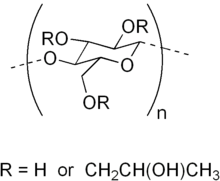 | |
| Names | |
|---|---|
| Other names Cellulose, 2-hydroxypropyl ether; oxypropylated cellulose; E463; hyprolose | |
| Identifiers | |
| CAS Number | |
| ChEMBL | |
| ChemSpider |
|
| DrugBank | |
| ECHA InfoCard | 100.116.338 |
| E number | E463 (thickeners, ...) |
| UNII | |
| CompTox Dashboard (EPA) | |
| Properties | |
| Chemical formula | variable |
| Molar mass | variable |
| Except where otherwise noted, data are given for materials in their standard state (at 25 °C , 100 kPa).
| |
Hydroxypropyl cellulose (HPC) is a derivative of cellulose with both water solubility and organic solubility. It is used as an excipient, and topical ophthalmic protectant and lubricant.
Chemistry
HPC is an ether of cellulose in which some of the hydroxyl groups in the repeating glucose units have been hydroxypropylated forming -OCH2CH(OH)CH3 groups using propylene oxide. The average number of substituted hydroxyl groups per glucose unit is referred to as the degree of substitution (DS). Complete substitution would provide a DS of 3. Because the hydroxypropyl group added contains a hydroxyl group, this can also be etherified during preparation of HPC. When this occurs, the number of moles of hydroxypropyl groups per glucose ring, moles of substitution (MS), can be higher than 3.
Because cellulose is very crystalline, HPC must have an MS about 4 in order to reach a good solubility in water. HPC has a combination of hydrophobic and hydrophilic groups, so it has a lower critical solution temperature (LCST) at 45 °C. At temperatures below the LCST, HPC is readily soluble in water; above the LCST, HPC is not soluble.
HPC forms liquid crystals and many mesophases according to its concentration in water. Such mesophases include isotropic, anisotropic, nematic and cholesteric. The last one gives many colors such as violet, green and red.
Uses
Lacrisert, manufactured by Aton Pharma, is a formulation of HPC used for artificial tears. It is used to treat medical conditions characterized by insufficient tear production such as keratoconjunctivitis sicca), recurrent corneal erosions, decreased corneal sensitivity, exposure and neuroparalytic keratitis. HPC is also used as a lubricant for artificial eyes. HPC is used as a thickener, a low level binder and as an emulsion stabiliser with E number E463. In pharmaceuticals it is used as a binder in tablets.
HPC is used as a sieving matrix for DNA separations by capillary and microchip electrophoresis.
HPC is used as a thickener, emulsifier, and stabilizer in cosmetic formulations such as shampoos, conditioners, and lotions.
HPC is the main ingredient in Cellugel, which is used in book conservation. Cellugel is described as "A safe, penetrating consolidant for leather book covers affected by red rot" and is produced by Preservation Solutions.
See also
Notes and references
- Barty-King, Charles; Chan, Chun Lam Clement; Parker, Richard; Bay, Mélanie; Vadrucci, Roberto; De Volder, Michael; Vignolini, Silvia (29 July 2021). "Mechanochromic, Structurally Colored, and Edible Hydrogels Prepared from Hydroxypropyl Cellulose and Gelatin". Advanced Materials. 33 (37): 2102112. Bibcode:2021AdM....3302112B. doi:10.1002/adma.202102112. PMID 34323315. S2CID 236497081.
- Luchs J, Nelinson D, Macy J (December 2010). "Efficacy of hydroxypropyl cellulose inserts (LACRISERT®) in subsets of patients with dry eye syndrome (DES): Findings from a patient registry". Cornea. 29 (12): 1417–1427. doi:10.1097/ICO.0b013e3181e3f05b. PMID 20847657. S2CID 40120861.
- McDonald M; D’Aversa G; Perry D; Wittpenn J; Nelinson D (Oct 2010). "Correlating patient-reported response to Hydroxypropyl cellulose ophthalmic insert (LACRISERT®) therapy with clinical outcomes: tools for predicting response". Curr Eye Res. 35 (10): 880–887. doi:10.3109/02713683.2010.495811. PMID 20858108. S2CID 207450381.
- Koffler B, McDonald M, Nelinson D (May 2010). "Improvement in clinical signs, symptoms, and QoL associated with DES: Hydroxypropyl Cellulose Ophthalmic Insert Patient Registry". Eye & Contact Lens. 36 (3): 170–176. doi:10.1097/ICL.0b013e3181db352f. PMID 20351555. S2CID 1751728.
- Weiner, Myra L.; Lois A. Kotkoskie (1999). Excipient Toxicity and Safety. Taylor & Francis. p. 8. ISBN 978-0-8247-8210-8.
- Sanders, Joshua C.; Breadmore, Michael C.; Kwok, Yien C.; Horsman, Katie M.; Landers, James P. (February 2003). "Hydroxypropyl Cellulose as an Adsorptive Coating Sieving Matrix for DNA Separations: Artificial Neural Network Optimization for Microchip Analysis". Analytical Chemistry. 75 (4): 986–994. doi:10.1021/ac020425z. PMID 12622396. INIST 14571070.
- "Hydroxypropyl Cellulose". kimachemical.com. Retrieved 7 March 2023.
- "Cellugel". Conservationresources.com. Retrieved 2021-12-20.